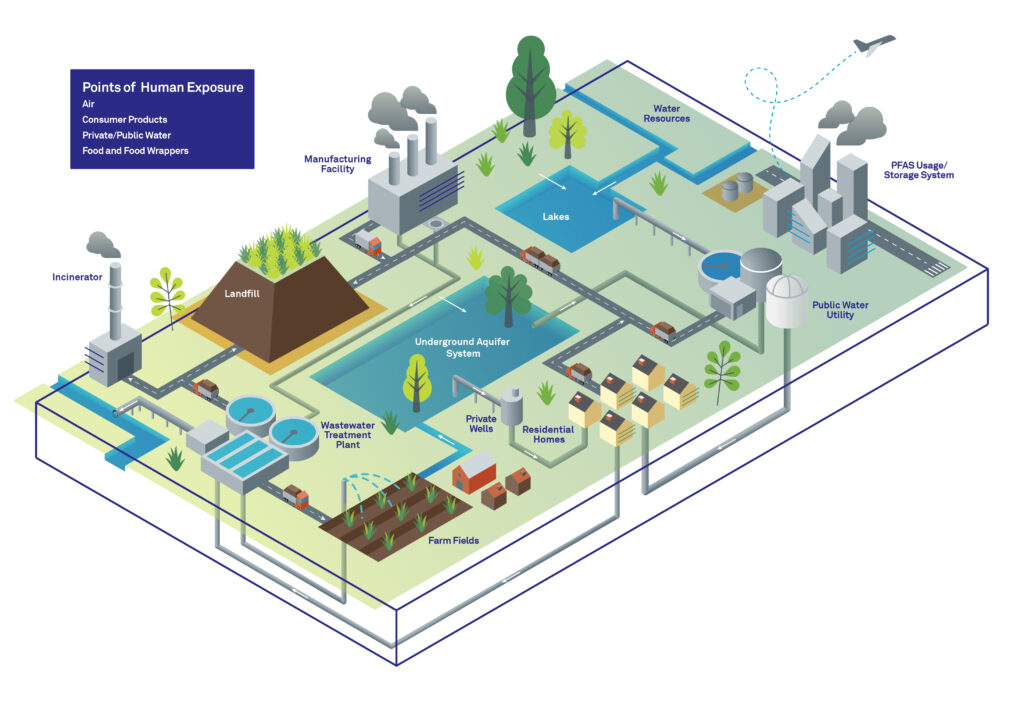Emerging Contaminants and PFAS
Emerging Contaminants and PFAS
Developing strategies and evaluating options in this time of rapidly evolving regulations
As a firm focused on water, BC has a unique perspective on the intersection of emerging contaminants in the water cycle. We’re focused on delivering sophisticated, yet practical solutions from source identification and sampling of per- and polyfluoroalkyl substances (PFAS) to developing and delivering remediation strategies for microplastics, and potential endocrine disruptive chemicals from pharmaceutical and personal care products.
We focus on long-term reliability, protection of public health and the environment, risk management, and innovative technology when needed. We’re working with coalitions, leading industry organizations, academia, and other partners to apply scientific principles and peer-reviewed research to influence and shape emerging contaminant regulations.
What are emerging contaminants?
Chemicals and compounds from pharmaceutical, manufacturing, and personal care products that are detected at low levels in the water cycle and may impact our environment, aquatic organisms, or human health. Emerging contaminants frequently include, but are not limited to, per- and polyfluoroalkyl substances (PFAS), perfluorooctanoic acid (PFOA), perfluorooctanesulfonic acid (PFOS), GenX chemicals, 1,2,3-trichloropropane (1,2,3-TCP), 1,4-dioxane, microplastics, and other endocrine disruptors.
EPA’s National Primary Drinking Water Regulation
Free PFAS Drinking Water Standards Quick Reference and Sampling Checklist to track ongoing compliance monitoring at your facility.
We can help you adapt to what’s emerging. The U.S. EPA’s National Primary Drinking Water Regulation establishes Maximum Contaminant Levels (MCLs) for six PFAS in drinking water. Public water systems must monitor for these PFAS and have three years to complete initial monitoring (by mid-2027), followed by ongoing compliance monitoring.
Download, print, and post BC’s free PFAS Drinking Water Standards Reference and Sampling Checklist for an at-a-glance reference to:
- Regulation Overview
- Hazard Index Calculation
- FAQs
- Monitoring Requirements and Sampling Tracker

PFAS in the water cycle
PFAS chemicals have been manufactured and broadly used in commerce with little to no restrictions since the 1940s. As a result of this usage, PFAS have entered the water cycle and the environment from many sources. The potential for human exposure exists from consumer products, airborne particulate, crops, fish and grazing animals, food packaging (grease repellents), and groundwater supplies. BC is partnering with clients at all points of the water cycle to formulate actionable solutions that protect public health and the environment, and take into account rapidly changing regulations and shifting state policies.
Services
Our emerging contaminants and PFAS services address the diverse and unique challenges facing clients.
Shaping science-based policy
Through our collaboration with leading industry organizations such as the Interstate Technology & Regulatory Council (ITRC), partnering with clients to respond to regulator inquiries, and advising newly formed PFAS coalitions, BC’s experts are providing objective, scientifically-based information to shape state and federal regulations. Our regulatory experts across the U.S. maintain strong working relationships with local, state, and federal agencies to help clients negotiate favorable outcomes that protect public health and the environment and achieve other business objectives.
Treatability Testing
Our state-of-the-art testing laboratory is well equipped and staffed to evaluate PFAS and emerging contaminant treatment options quickly and with confidence, potentially reducing the cost and risk associated with facility design, construction, and operation. From rapid analysis using conventional physical, chemical, and biological methods, we quickly provide answers and solutions that keep pace with regulatory actions and fully address public concerns.
Treatment Technologies
We are working with various technology developers to advance innovative, destructive technologies and site management approaches that could potentially achieve cost effective and reliable solutions that minimize liabilities.
Related News
Preventing the migration of microplastics
California Water Environment Association (CWEA) Annual Conference and Expo
Florida Water Resources Conference
Global Waste Management Symposium
NEWEA 2024 Annual Conference and Exhibit
BC Insider: EPA POTW Influent Study draft offers clues to prepare
Related News
Related Videos and Podcasts
Impacts and costs of PFAS in wastewater and biosolids
Dr. Allegra da Silva and Sarah Reeves join ‘Streaming Water’ podcast to discuss PFAS
PFAS contamination and treatment with Dr. Erin Mackey
Related Papers and Reports
- Fate of perfluoroalkyl and polyfluoroalkyl substances (PFAS) through two full-scale wastewater sludge incinerators
- An Evaluation of Biosolids Management in Maine and Recommendations for the Future
- PFAS Fate in Pyrolysis System Reflecting Full-Scale Configurations – Thermal Oxidizer Impacts
- A novel approach to interpret quasi-collimated beam results to support design and scale-up of vacuum UV based AOPs
- Optimal Integration of Vacuum UV With Granular Biofiltration for Advanced Wastewater Treatment: Impact of Process Sequence on Cecs Removal and Microbial Ecology
- Closed-Circuit High-Pressure Membrane Systems for the Separation of Per and Polyfluoroalkyl Substances
